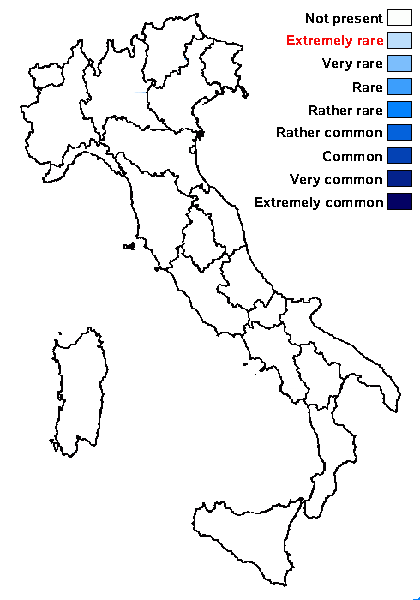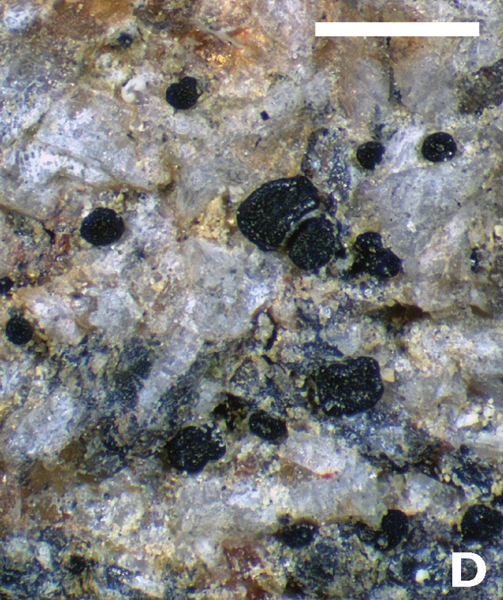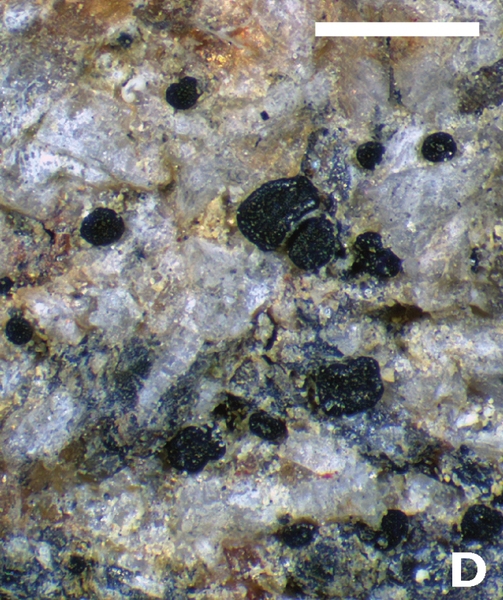Leimonis lynceola (Th. Fr.) Aptroot
Index Fungorum, 331: 1, 2017. Basionym: Lecidea lynceola Th. Fr. - Lich. Scand., 2: 561, 1874
Synonyms: Micarea excipulata Coppins; Micarea lynceola (Th. Fr.) Palice
Distribution:
Description: Thallus crustose, very thinly episubstratic, inconspicuous, effuse, pale buff to dull greenish. Apothecia biatorine, numerous, black when dry, bluish grey when wet, flat to slightly convex, not tuberculate, 0.15-0.4 mm across, with a thin, soon excluded proper margin. Proper exciple well-developed, especially in young apothecia, 30-40 μm wide laterally, slightly bluish green, aeruginose or olivaceous in outer part, colourless within, of radiating and branched hyphae, K/I-; epithecium poorly differentiated from the hymenium, bluish green or olivaceous, K-; hymenium colourless, 38-45 μm high, K/I+ blue; paraphyses rather scarce, monomorphic, sparingly branched, 1-1.3 μm thick at mid-level, only slightly widening toward apices, the apical cells up to 1.7 μm wide; hypothecium colourless or pale olivaceous green. Asci 8-spored, cylindrical-clavate, the I+ blue tholus with a wide, intensely I+ dark blue tube structure that expands towards the top, without a pale axial body. Ascospores 1-celled, hyaline, ovoid, (6-)7-9(-10) x 3-4(-5) μm. Pycnidia inconspicuous, immersed, 0.03-0.04 mm wide, black, the wall dark green, K-. Conidia 3-4.8 x 0.8-1 μm. Photobiont chlorococcoid, the cells 7-15(-20) μm wide. Spot tests: thallus K-, C-, KC-, P-, UV-. Chemistry: thallus without lichen substances.Note: a pioneer, ephemeral species usually growing on loose siliceous pebbles, often in disturbed habitats such as along mountain trails in humid situations; widespread in Europe but not common, perhaps often overlooked, with a single record from the Eastern Alps (Carinthia, Austria); to be looked for in the Italian Alps.
Growth form: Crustose
Substrata: rocks
Photobiont: green algae other than Trentepohlia
Reproductive strategy: mainly sexual
Pioneer species

Predictive model
Growth form: Crustose
Substrata: rocks
Photobiont: green algae other than Trentepohlia
Reproductive strategy: mainly sexual
Pioneer species

Predictive model
 Index Fungorum
Index Fungorum
 GBIF
GBIF



